WLCBMS: Level 5 Health and Social Care Obesity Research Project
VerifiedAdded on 2021/04/16
|23
|5309
|437
Report
AI Summary
This Level 5 Health and Social Care research project from West London College of Business and Management Sciences examines obesity as a significant health concern, exploring its causes, symptoms, treatments, and preventative measures. The research delves into the biological and scientific factors contributing to obesity, including lifestyle choices, genetic makeup, and public perception. The project investigates the impact of obesity on different age groups and genders, and analyzes various management techniques. The report includes a literature review discussing causes like dietary behavior, eating disorders, and sedentary lifestyles, as well as management strategies. The research methodology outlines the sources and methods of analysis used. Findings and conclusions are presented with recommendations for improving public health and gaining economic stability. The report also includes an abstract, table of contents, acknowledgements, and appendices.
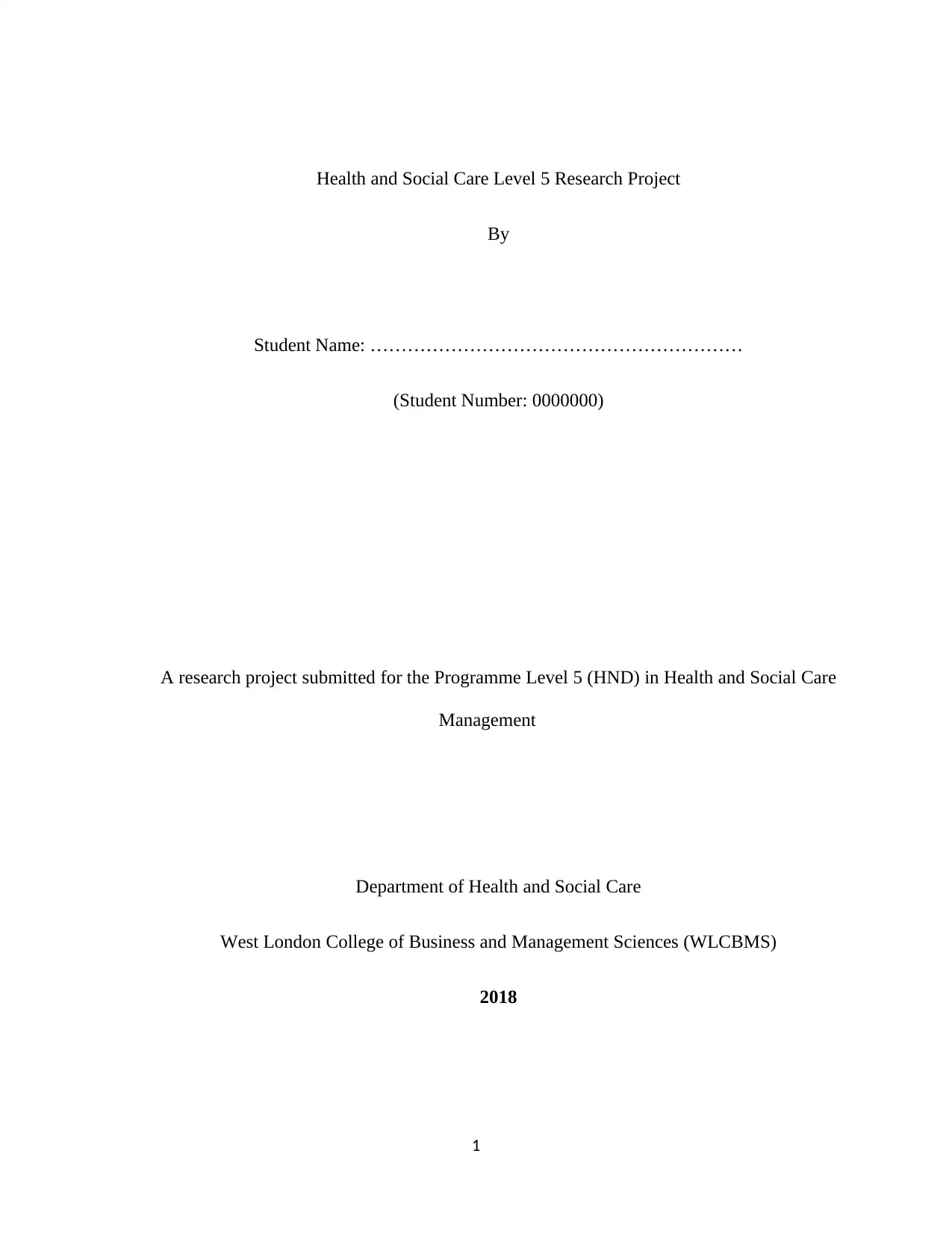
Health and Social Care Level 5 Research Project
By
Student Name: ……………………………………………………
(Student Number: 0000000)
A research project submitted for the Programme Level 5 (HND) in Health and Social Care
Management
Department of Health and Social Care
West London College of Business and Management Sciences (WLCBMS)
2018
1
By
Student Name: ……………………………………………………
(Student Number: 0000000)
A research project submitted for the Programme Level 5 (HND) in Health and Social Care
Management
Department of Health and Social Care
West London College of Business and Management Sciences (WLCBMS)
2018
1
Paraphrase This Document
Need a fresh take? Get an instant paraphrase of this document with our AI Paraphraser
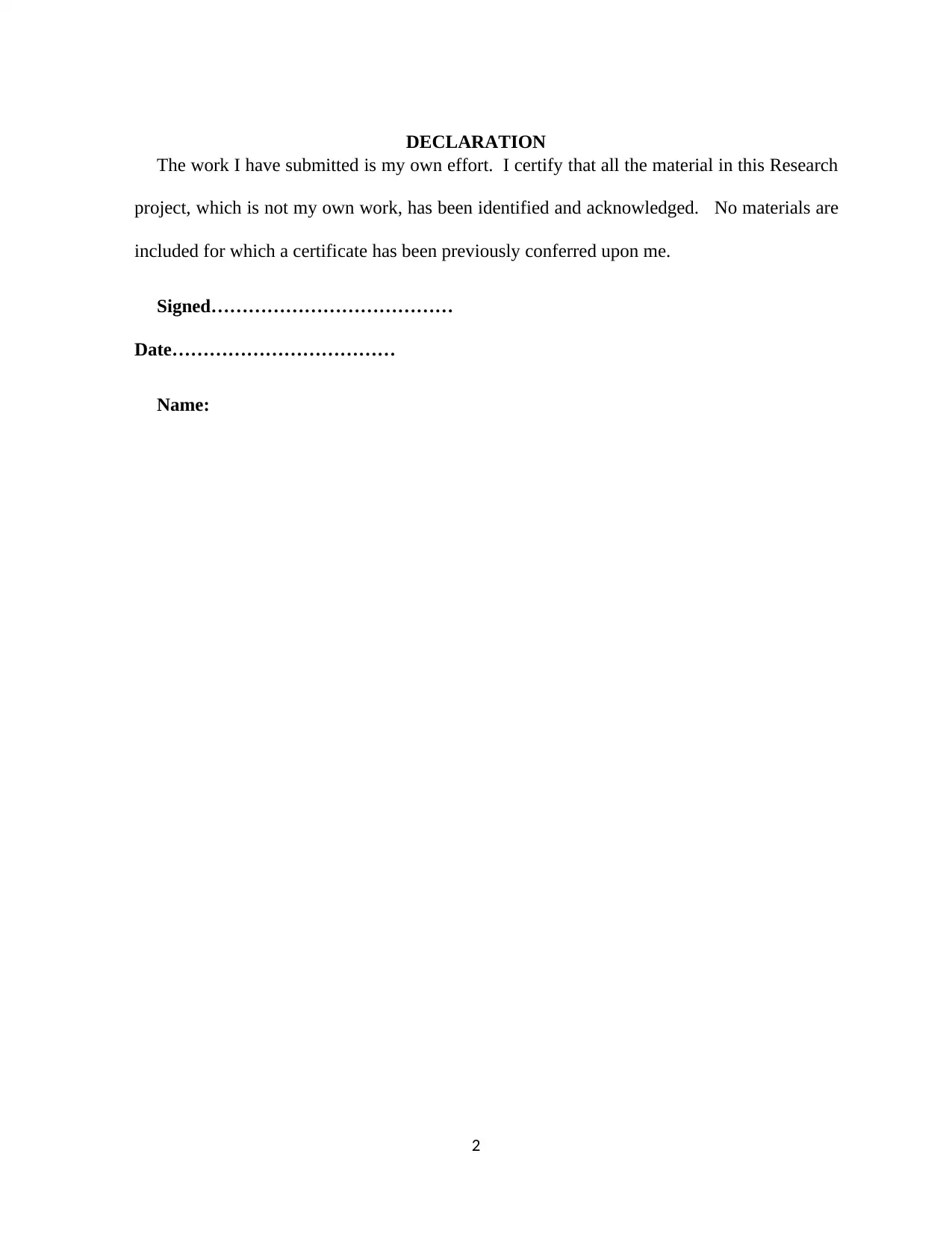
DECLARATION
The work I have submitted is my own effort. I certify that all the material in this Research
project, which is not my own work, has been identified and acknowledged. No materials are
included for which a certificate has been previously conferred upon me.
Signed…………………………………
Date………………………………
Name:
2
The work I have submitted is my own effort. I certify that all the material in this Research
project, which is not my own work, has been identified and acknowledged. No materials are
included for which a certificate has been previously conferred upon me.
Signed…………………………………
Date………………………………
Name:
2
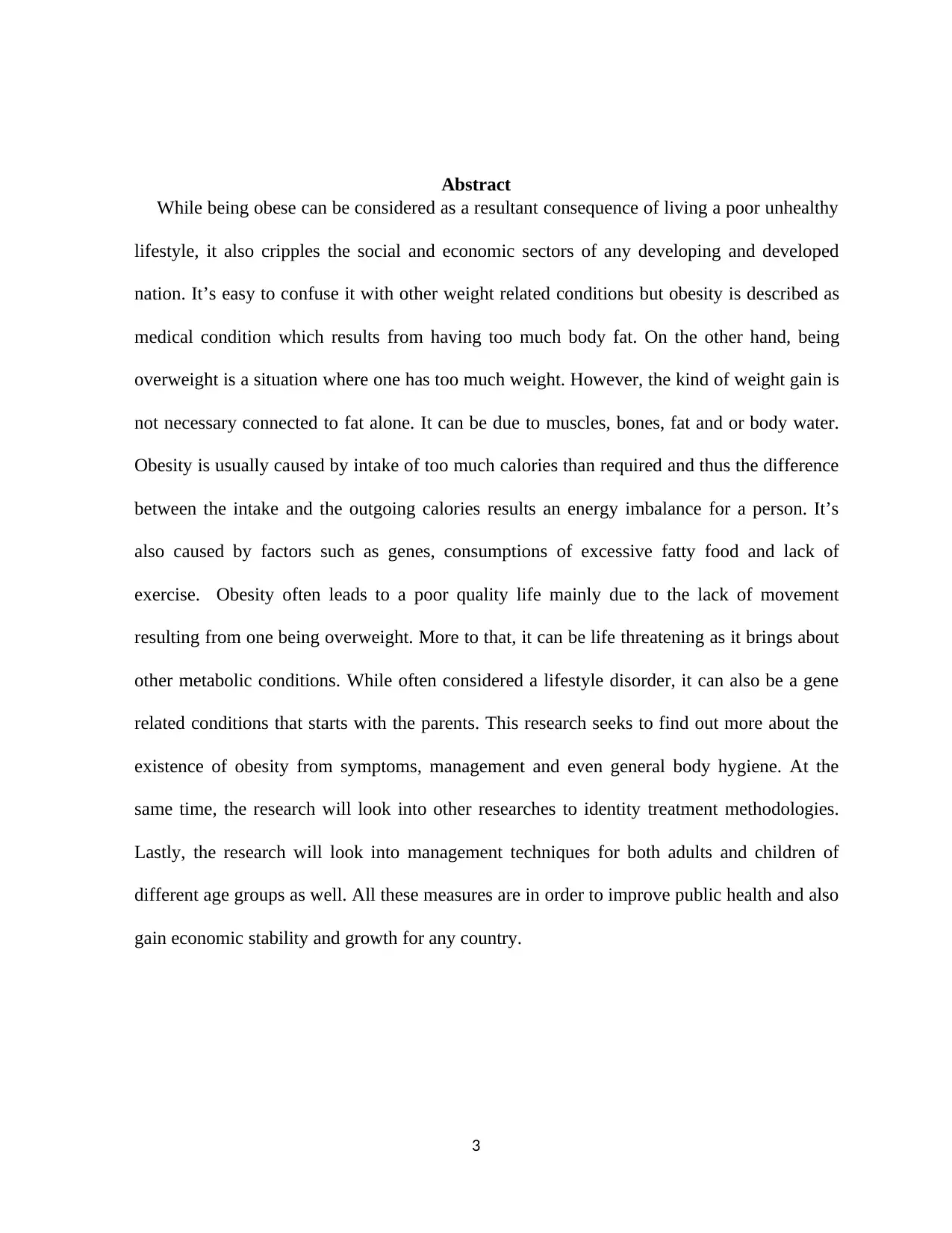
Abstract
While being obese can be considered as a resultant consequence of living a poor unhealthy
lifestyle, it also cripples the social and economic sectors of any developing and developed
nation. It’s easy to confuse it with other weight related conditions but obesity is described as
medical condition which results from having too much body fat. On the other hand, being
overweight is a situation where one has too much weight. However, the kind of weight gain is
not necessary connected to fat alone. It can be due to muscles, bones, fat and or body water.
Obesity is usually caused by intake of too much calories than required and thus the difference
between the intake and the outgoing calories results an energy imbalance for a person. It’s
also caused by factors such as genes, consumptions of excessive fatty food and lack of
exercise. Obesity often leads to a poor quality life mainly due to the lack of movement
resulting from one being overweight. More to that, it can be life threatening as it brings about
other metabolic conditions. While often considered a lifestyle disorder, it can also be a gene
related conditions that starts with the parents. This research seeks to find out more about the
existence of obesity from symptoms, management and even general body hygiene. At the
same time, the research will look into other researches to identity treatment methodologies.
Lastly, the research will look into management techniques for both adults and children of
different age groups as well. All these measures are in order to improve public health and also
gain economic stability and growth for any country.
3
While being obese can be considered as a resultant consequence of living a poor unhealthy
lifestyle, it also cripples the social and economic sectors of any developing and developed
nation. It’s easy to confuse it with other weight related conditions but obesity is described as
medical condition which results from having too much body fat. On the other hand, being
overweight is a situation where one has too much weight. However, the kind of weight gain is
not necessary connected to fat alone. It can be due to muscles, bones, fat and or body water.
Obesity is usually caused by intake of too much calories than required and thus the difference
between the intake and the outgoing calories results an energy imbalance for a person. It’s
also caused by factors such as genes, consumptions of excessive fatty food and lack of
exercise. Obesity often leads to a poor quality life mainly due to the lack of movement
resulting from one being overweight. More to that, it can be life threatening as it brings about
other metabolic conditions. While often considered a lifestyle disorder, it can also be a gene
related conditions that starts with the parents. This research seeks to find out more about the
existence of obesity from symptoms, management and even general body hygiene. At the
same time, the research will look into other researches to identity treatment methodologies.
Lastly, the research will look into management techniques for both adults and children of
different age groups as well. All these measures are in order to improve public health and also
gain economic stability and growth for any country.
3
⊘ This is a preview!⊘
Do you want full access?
Subscribe today to unlock all pages.

Trusted by 1+ million students worldwide
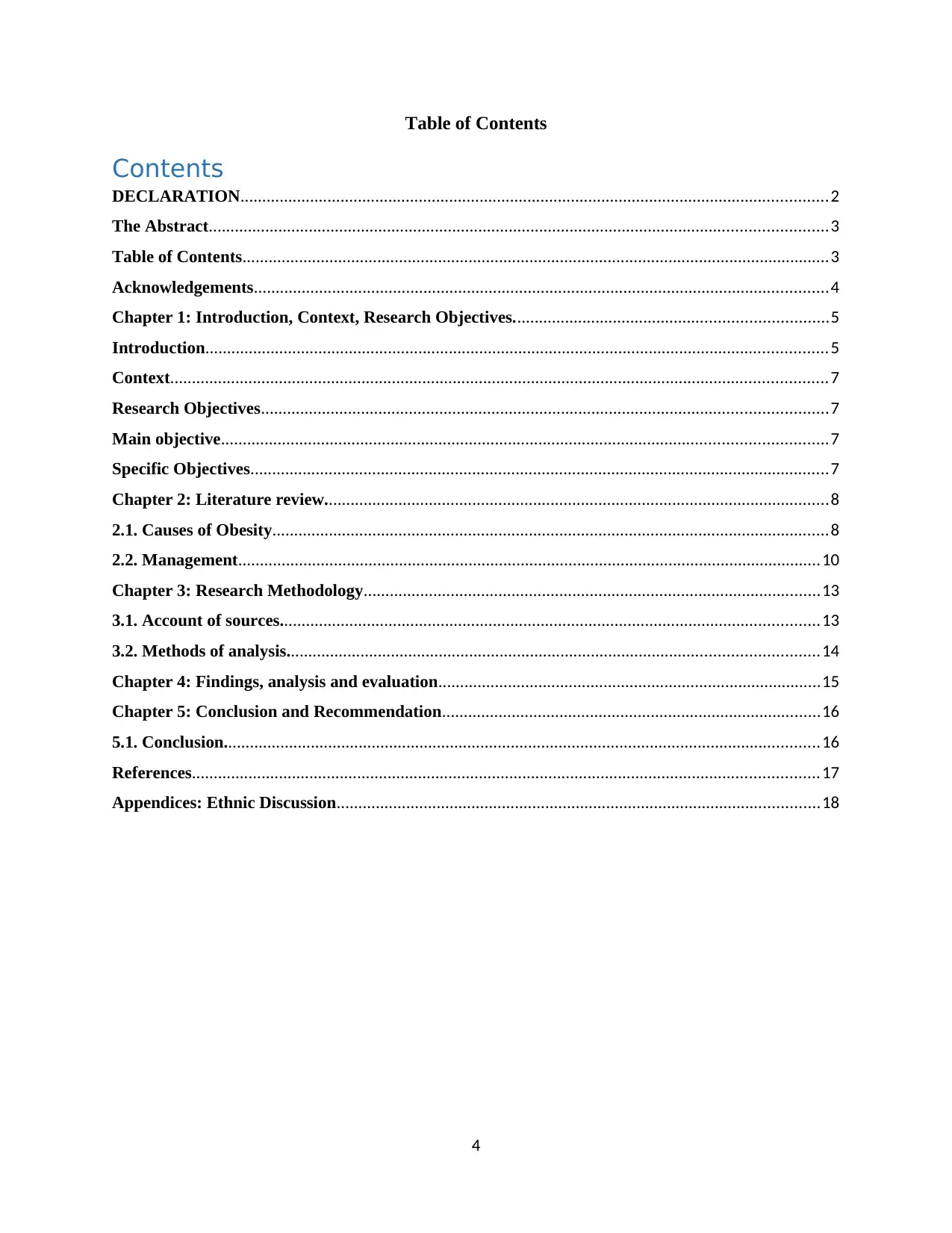
Table of Contents
Contents
DECLARATION.......................................................................................................................................2
The Abstract..............................................................................................................................................3
Table of Contents.......................................................................................................................................3
Acknowledgements....................................................................................................................................4
Chapter 1: Introduction, Context, Research Objectives........................................................................5
Introduction...............................................................................................................................................5
Context.......................................................................................................................................................7
Research Objectives..................................................................................................................................7
Main objective...........................................................................................................................................7
Specific Objectives.....................................................................................................................................7
Chapter 2: Literature review....................................................................................................................8
2.1. Causes of Obesity................................................................................................................................8
2.2. Management......................................................................................................................................10
Chapter 3: Research Methodology.........................................................................................................13
3.1. Account of sources............................................................................................................................13
3.2. Methods of analysis..........................................................................................................................14
Chapter 4: Findings, analysis and evaluation........................................................................................15
Chapter 5: Conclusion and Recommendation.......................................................................................16
5.1. Conclusion.........................................................................................................................................16
References................................................................................................................................................17
Appendices: Ethnic Discussion...............................................................................................................18
4
Contents
DECLARATION.......................................................................................................................................2
The Abstract..............................................................................................................................................3
Table of Contents.......................................................................................................................................3
Acknowledgements....................................................................................................................................4
Chapter 1: Introduction, Context, Research Objectives........................................................................5
Introduction...............................................................................................................................................5
Context.......................................................................................................................................................7
Research Objectives..................................................................................................................................7
Main objective...........................................................................................................................................7
Specific Objectives.....................................................................................................................................7
Chapter 2: Literature review....................................................................................................................8
2.1. Causes of Obesity................................................................................................................................8
2.2. Management......................................................................................................................................10
Chapter 3: Research Methodology.........................................................................................................13
3.1. Account of sources............................................................................................................................13
3.2. Methods of analysis..........................................................................................................................14
Chapter 4: Findings, analysis and evaluation........................................................................................15
Chapter 5: Conclusion and Recommendation.......................................................................................16
5.1. Conclusion.........................................................................................................................................16
References................................................................................................................................................17
Appendices: Ethnic Discussion...............................................................................................................18
4
Paraphrase This Document
Need a fresh take? Get an instant paraphrase of this document with our AI Paraphraser
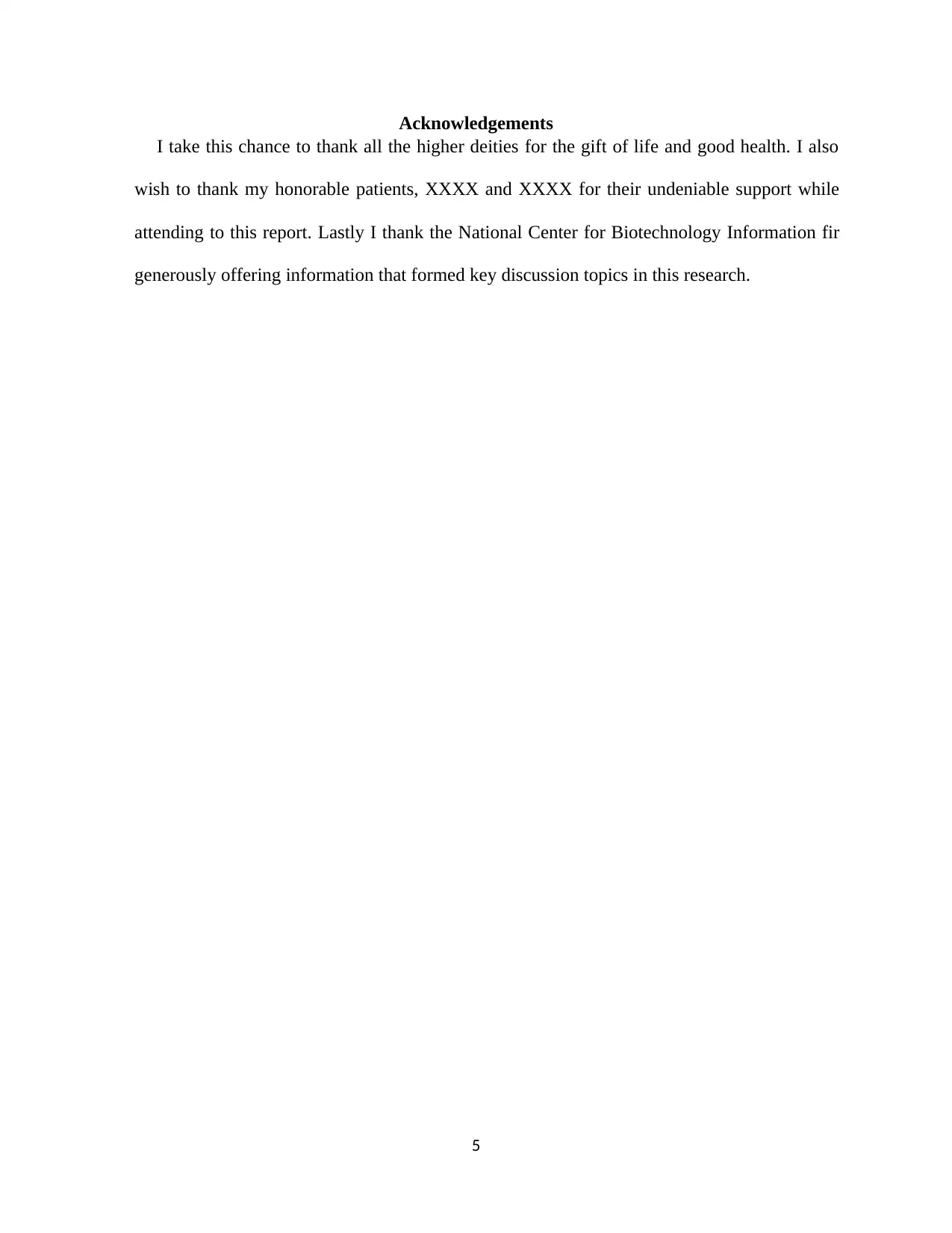
Acknowledgements
I take this chance to thank all the higher deities for the gift of life and good health. I also
wish to thank my honorable patients, XXXX and XXXX for their undeniable support while
attending to this report. Lastly I thank the National Center for Biotechnology Information fir
generously offering information that formed key discussion topics in this research.
5
I take this chance to thank all the higher deities for the gift of life and good health. I also
wish to thank my honorable patients, XXXX and XXXX for their undeniable support while
attending to this report. Lastly I thank the National Center for Biotechnology Information fir
generously offering information that formed key discussion topics in this research.
5
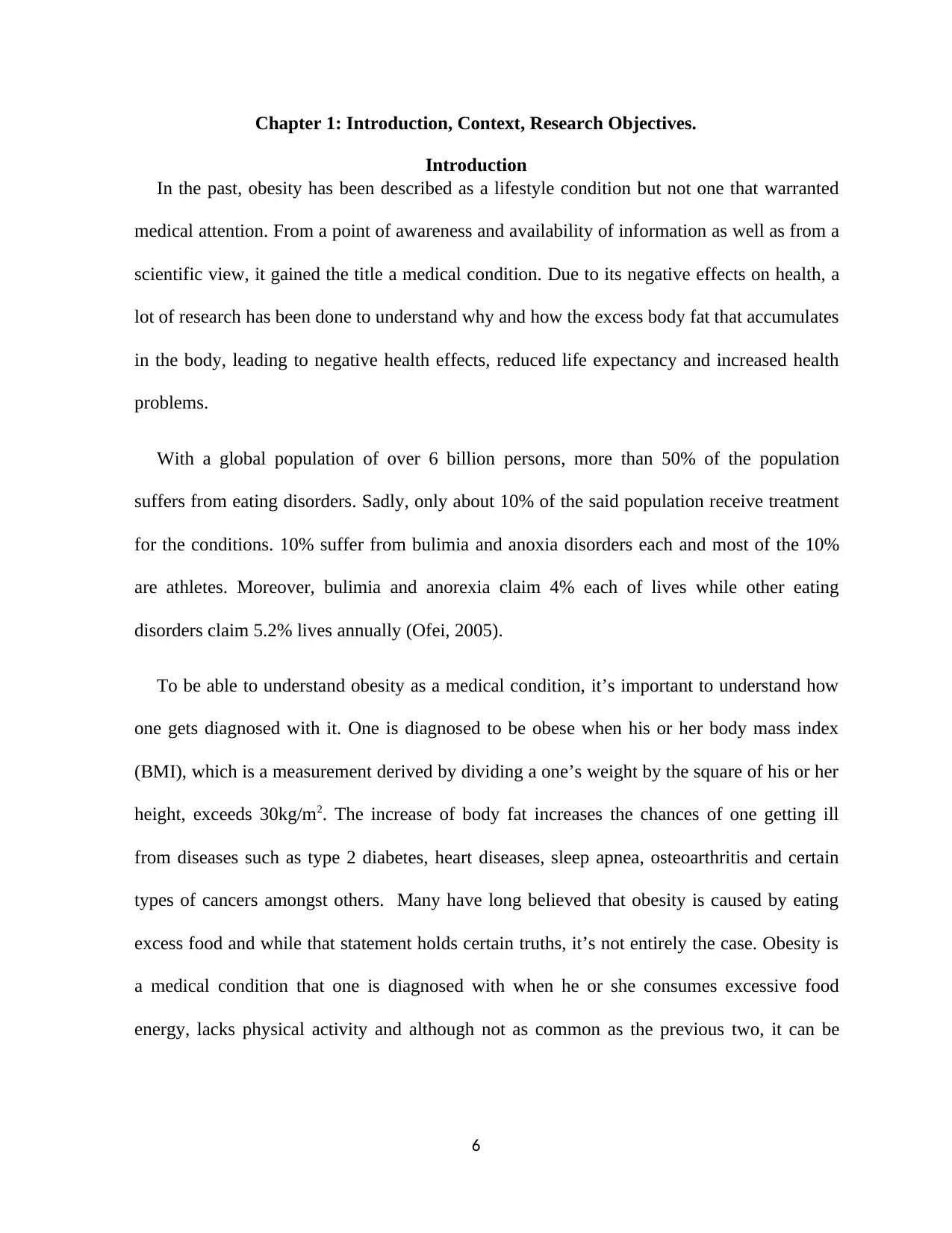
Chapter 1: Introduction, Context, Research Objectives.
Introduction
In the past, obesity has been described as a lifestyle condition but not one that warranted
medical attention. From a point of awareness and availability of information as well as from a
scientific view, it gained the title a medical condition. Due to its negative effects on health, a
lot of research has been done to understand why and how the excess body fat that accumulates
in the body, leading to negative health effects, reduced life expectancy and increased health
problems.
With a global population of over 6 billion persons, more than 50% of the population
suffers from eating disorders. Sadly, only about 10% of the said population receive treatment
for the conditions. 10% suffer from bulimia and anoxia disorders each and most of the 10%
are athletes. Moreover, bulimia and anorexia claim 4% each of lives while other eating
disorders claim 5.2% lives annually (Ofei, 2005).
To be able to understand obesity as a medical condition, it’s important to understand how
one gets diagnosed with it. One is diagnosed to be obese when his or her body mass index
(BMI), which is a measurement derived by dividing a one’s weight by the square of his or her
height, exceeds 30kg/m2. The increase of body fat increases the chances of one getting ill
from diseases such as type 2 diabetes, heart diseases, sleep apnea, osteoarthritis and certain
types of cancers amongst others. Many have long believed that obesity is caused by eating
excess food and while that statement holds certain truths, it’s not entirely the case. Obesity is
a medical condition that one is diagnosed with when he or she consumes excessive food
energy, lacks physical activity and although not as common as the previous two, it can be
6
Introduction
In the past, obesity has been described as a lifestyle condition but not one that warranted
medical attention. From a point of awareness and availability of information as well as from a
scientific view, it gained the title a medical condition. Due to its negative effects on health, a
lot of research has been done to understand why and how the excess body fat that accumulates
in the body, leading to negative health effects, reduced life expectancy and increased health
problems.
With a global population of over 6 billion persons, more than 50% of the population
suffers from eating disorders. Sadly, only about 10% of the said population receive treatment
for the conditions. 10% suffer from bulimia and anoxia disorders each and most of the 10%
are athletes. Moreover, bulimia and anorexia claim 4% each of lives while other eating
disorders claim 5.2% lives annually (Ofei, 2005).
To be able to understand obesity as a medical condition, it’s important to understand how
one gets diagnosed with it. One is diagnosed to be obese when his or her body mass index
(BMI), which is a measurement derived by dividing a one’s weight by the square of his or her
height, exceeds 30kg/m2. The increase of body fat increases the chances of one getting ill
from diseases such as type 2 diabetes, heart diseases, sleep apnea, osteoarthritis and certain
types of cancers amongst others. Many have long believed that obesity is caused by eating
excess food and while that statement holds certain truths, it’s not entirely the case. Obesity is
a medical condition that one is diagnosed with when he or she consumes excessive food
energy, lacks physical activity and although not as common as the previous two, it can be
6
⊘ This is a preview!⊘
Do you want full access?
Subscribe today to unlock all pages.

Trusted by 1+ million students worldwide
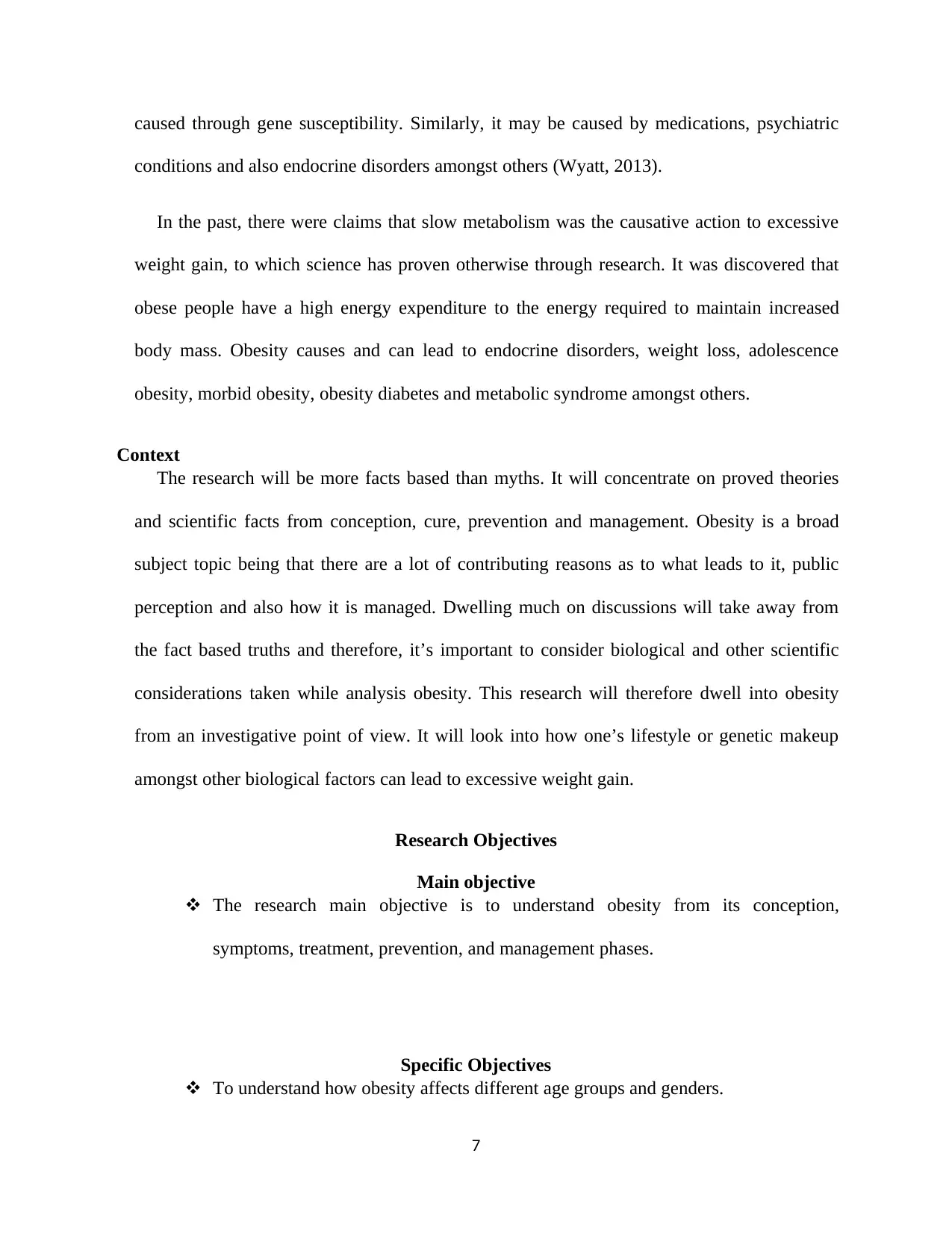
caused through gene susceptibility. Similarly, it may be caused by medications, psychiatric
conditions and also endocrine disorders amongst others (Wyatt, 2013).
In the past, there were claims that slow metabolism was the causative action to excessive
weight gain, to which science has proven otherwise through research. It was discovered that
obese people have a high energy expenditure to the energy required to maintain increased
body mass. Obesity causes and can lead to endocrine disorders, weight loss, adolescence
obesity, morbid obesity, obesity diabetes and metabolic syndrome amongst others.
Context
The research will be more facts based than myths. It will concentrate on proved theories
and scientific facts from conception, cure, prevention and management. Obesity is a broad
subject topic being that there are a lot of contributing reasons as to what leads to it, public
perception and also how it is managed. Dwelling much on discussions will take away from
the fact based truths and therefore, it’s important to consider biological and other scientific
considerations taken while analysis obesity. This research will therefore dwell into obesity
from an investigative point of view. It will look into how one’s lifestyle or genetic makeup
amongst other biological factors can lead to excessive weight gain.
Research Objectives
Main objective
The research main objective is to understand obesity from its conception,
symptoms, treatment, prevention, and management phases.
Specific Objectives
To understand how obesity affects different age groups and genders.
7
conditions and also endocrine disorders amongst others (Wyatt, 2013).
In the past, there were claims that slow metabolism was the causative action to excessive
weight gain, to which science has proven otherwise through research. It was discovered that
obese people have a high energy expenditure to the energy required to maintain increased
body mass. Obesity causes and can lead to endocrine disorders, weight loss, adolescence
obesity, morbid obesity, obesity diabetes and metabolic syndrome amongst others.
Context
The research will be more facts based than myths. It will concentrate on proved theories
and scientific facts from conception, cure, prevention and management. Obesity is a broad
subject topic being that there are a lot of contributing reasons as to what leads to it, public
perception and also how it is managed. Dwelling much on discussions will take away from
the fact based truths and therefore, it’s important to consider biological and other scientific
considerations taken while analysis obesity. This research will therefore dwell into obesity
from an investigative point of view. It will look into how one’s lifestyle or genetic makeup
amongst other biological factors can lead to excessive weight gain.
Research Objectives
Main objective
The research main objective is to understand obesity from its conception,
symptoms, treatment, prevention, and management phases.
Specific Objectives
To understand how obesity affects different age groups and genders.
7
Paraphrase This Document
Need a fresh take? Get an instant paraphrase of this document with our AI Paraphraser

To understand the public perception of the illness.
To understand preventative and management measures adopted over time, and their
effectiveness in curbing the illness and lastly,
To analyze the different ways of managing obesity and risk factors involved.
8
To understand preventative and management measures adopted over time, and their
effectiveness in curbing the illness and lastly,
To analyze the different ways of managing obesity and risk factors involved.
8
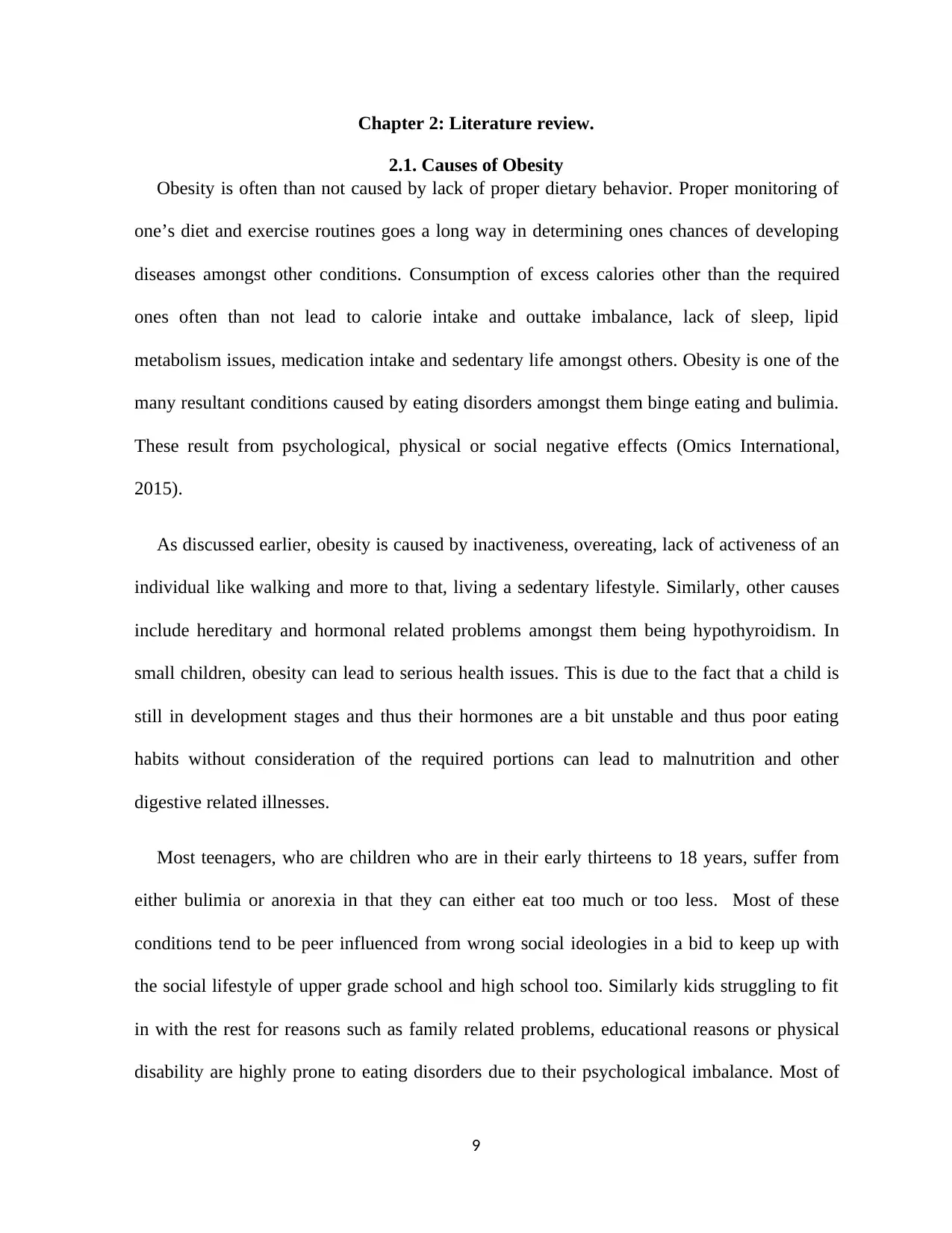
Chapter 2: Literature review.
2.1. Causes of Obesity
Obesity is often than not caused by lack of proper dietary behavior. Proper monitoring of
one’s diet and exercise routines goes a long way in determining ones chances of developing
diseases amongst other conditions. Consumption of excess calories other than the required
ones often than not lead to calorie intake and outtake imbalance, lack of sleep, lipid
metabolism issues, medication intake and sedentary life amongst others. Obesity is one of the
many resultant conditions caused by eating disorders amongst them binge eating and bulimia.
These result from psychological, physical or social negative effects (Omics International,
2015).
As discussed earlier, obesity is caused by inactiveness, overeating, lack of activeness of an
individual like walking and more to that, living a sedentary lifestyle. Similarly, other causes
include hereditary and hormonal related problems amongst them being hypothyroidism. In
small children, obesity can lead to serious health issues. This is due to the fact that a child is
still in development stages and thus their hormones are a bit unstable and thus poor eating
habits without consideration of the required portions can lead to malnutrition and other
digestive related illnesses.
Most teenagers, who are children who are in their early thirteens to 18 years, suffer from
either bulimia or anorexia in that they can either eat too much or too less. Most of these
conditions tend to be peer influenced from wrong social ideologies in a bid to keep up with
the social lifestyle of upper grade school and high school too. Similarly kids struggling to fit
in with the rest for reasons such as family related problems, educational reasons or physical
disability are highly prone to eating disorders due to their psychological imbalance. Most of
9
2.1. Causes of Obesity
Obesity is often than not caused by lack of proper dietary behavior. Proper monitoring of
one’s diet and exercise routines goes a long way in determining ones chances of developing
diseases amongst other conditions. Consumption of excess calories other than the required
ones often than not lead to calorie intake and outtake imbalance, lack of sleep, lipid
metabolism issues, medication intake and sedentary life amongst others. Obesity is one of the
many resultant conditions caused by eating disorders amongst them binge eating and bulimia.
These result from psychological, physical or social negative effects (Omics International,
2015).
As discussed earlier, obesity is caused by inactiveness, overeating, lack of activeness of an
individual like walking and more to that, living a sedentary lifestyle. Similarly, other causes
include hereditary and hormonal related problems amongst them being hypothyroidism. In
small children, obesity can lead to serious health issues. This is due to the fact that a child is
still in development stages and thus their hormones are a bit unstable and thus poor eating
habits without consideration of the required portions can lead to malnutrition and other
digestive related illnesses.
Most teenagers, who are children who are in their early thirteens to 18 years, suffer from
either bulimia or anorexia in that they can either eat too much or too less. Most of these
conditions tend to be peer influenced from wrong social ideologies in a bid to keep up with
the social lifestyle of upper grade school and high school too. Similarly kids struggling to fit
in with the rest for reasons such as family related problems, educational reasons or physical
disability are highly prone to eating disorders due to their psychological imbalance. Most of
9
⊘ This is a preview!⊘
Do you want full access?
Subscribe today to unlock all pages.

Trusted by 1+ million students worldwide
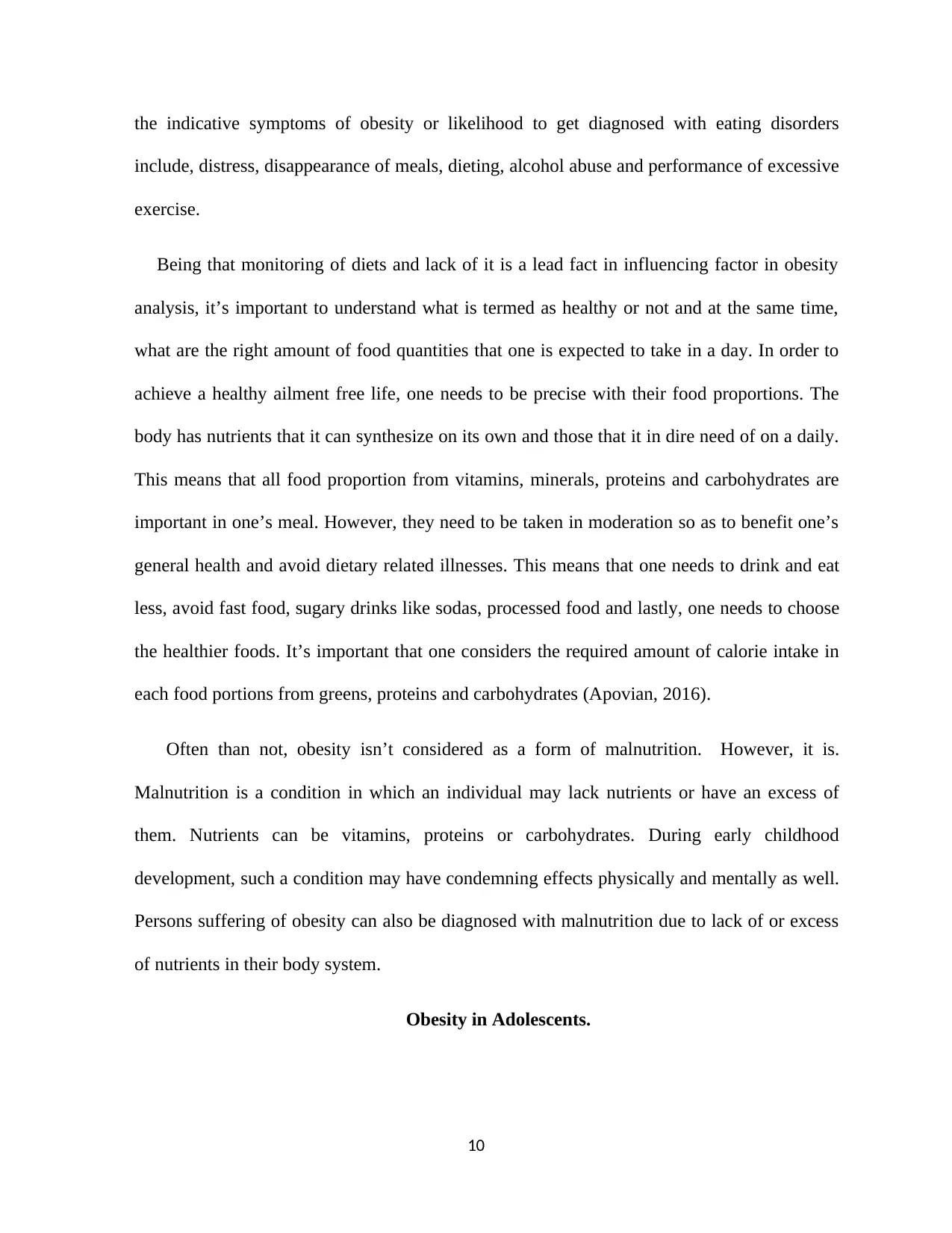
the indicative symptoms of obesity or likelihood to get diagnosed with eating disorders
include, distress, disappearance of meals, dieting, alcohol abuse and performance of excessive
exercise.
Being that monitoring of diets and lack of it is a lead fact in influencing factor in obesity
analysis, it’s important to understand what is termed as healthy or not and at the same time,
what are the right amount of food quantities that one is expected to take in a day. In order to
achieve a healthy ailment free life, one needs to be precise with their food proportions. The
body has nutrients that it can synthesize on its own and those that it in dire need of on a daily.
This means that all food proportion from vitamins, minerals, proteins and carbohydrates are
important in one’s meal. However, they need to be taken in moderation so as to benefit one’s
general health and avoid dietary related illnesses. This means that one needs to drink and eat
less, avoid fast food, sugary drinks like sodas, processed food and lastly, one needs to choose
the healthier foods. It’s important that one considers the required amount of calorie intake in
each food portions from greens, proteins and carbohydrates (Apovian, 2016).
Often than not, obesity isn’t considered as a form of malnutrition. However, it is.
Malnutrition is a condition in which an individual may lack nutrients or have an excess of
them. Nutrients can be vitamins, proteins or carbohydrates. During early childhood
development, such a condition may have condemning effects physically and mentally as well.
Persons suffering of obesity can also be diagnosed with malnutrition due to lack of or excess
of nutrients in their body system.
Obesity in Adolescents.
10
include, distress, disappearance of meals, dieting, alcohol abuse and performance of excessive
exercise.
Being that monitoring of diets and lack of it is a lead fact in influencing factor in obesity
analysis, it’s important to understand what is termed as healthy or not and at the same time,
what are the right amount of food quantities that one is expected to take in a day. In order to
achieve a healthy ailment free life, one needs to be precise with their food proportions. The
body has nutrients that it can synthesize on its own and those that it in dire need of on a daily.
This means that all food proportion from vitamins, minerals, proteins and carbohydrates are
important in one’s meal. However, they need to be taken in moderation so as to benefit one’s
general health and avoid dietary related illnesses. This means that one needs to drink and eat
less, avoid fast food, sugary drinks like sodas, processed food and lastly, one needs to choose
the healthier foods. It’s important that one considers the required amount of calorie intake in
each food portions from greens, proteins and carbohydrates (Apovian, 2016).
Often than not, obesity isn’t considered as a form of malnutrition. However, it is.
Malnutrition is a condition in which an individual may lack nutrients or have an excess of
them. Nutrients can be vitamins, proteins or carbohydrates. During early childhood
development, such a condition may have condemning effects physically and mentally as well.
Persons suffering of obesity can also be diagnosed with malnutrition due to lack of or excess
of nutrients in their body system.
Obesity in Adolescents.
10
Paraphrase This Document
Need a fresh take? Get an instant paraphrase of this document with our AI Paraphraser
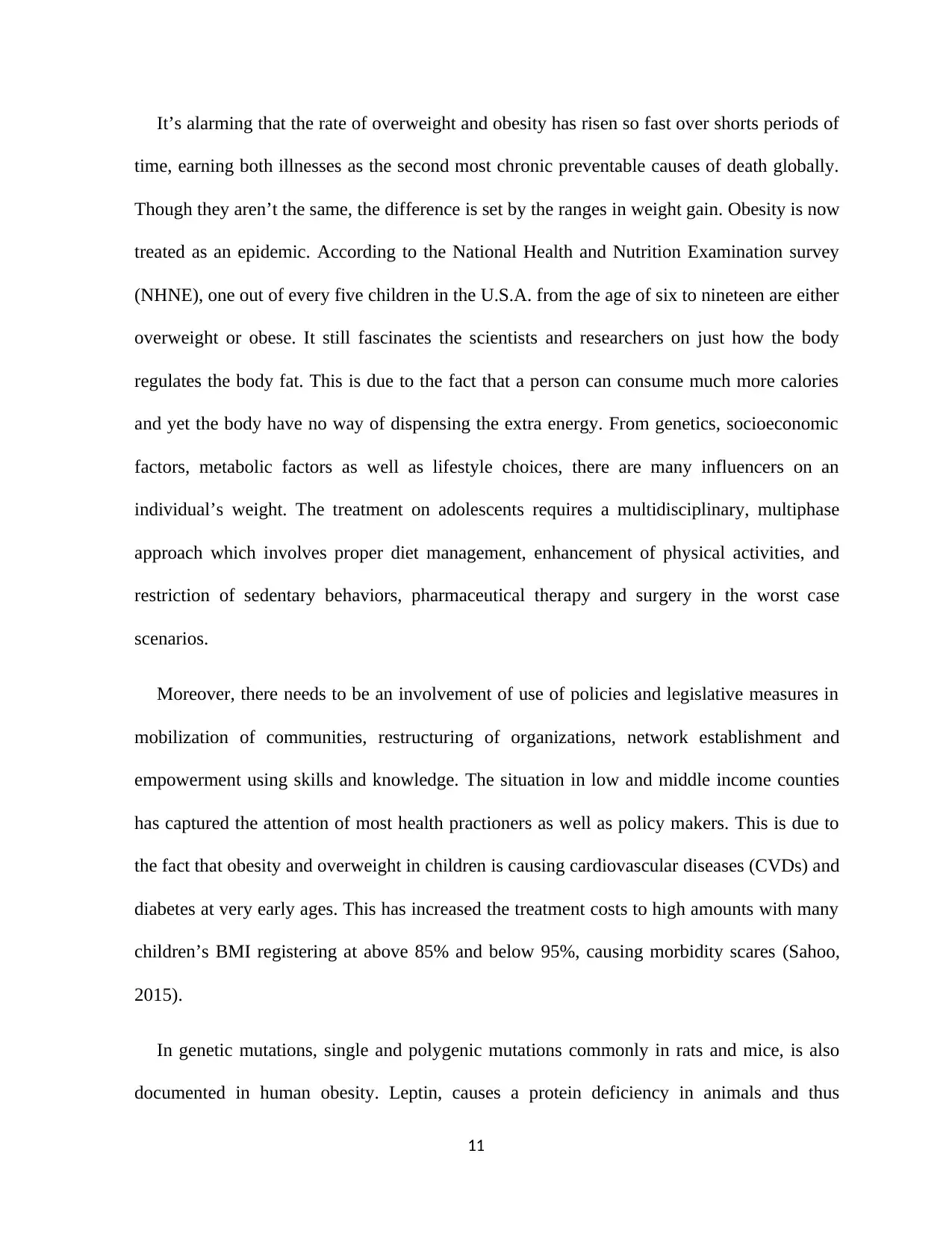
It’s alarming that the rate of overweight and obesity has risen so fast over shorts periods of
time, earning both illnesses as the second most chronic preventable causes of death globally.
Though they aren’t the same, the difference is set by the ranges in weight gain. Obesity is now
treated as an epidemic. According to the National Health and Nutrition Examination survey
(NHNE), one out of every five children in the U.S.A. from the age of six to nineteen are either
overweight or obese. It still fascinates the scientists and researchers on just how the body
regulates the body fat. This is due to the fact that a person can consume much more calories
and yet the body have no way of dispensing the extra energy. From genetics, socioeconomic
factors, metabolic factors as well as lifestyle choices, there are many influencers on an
individual’s weight. The treatment on adolescents requires a multidisciplinary, multiphase
approach which involves proper diet management, enhancement of physical activities, and
restriction of sedentary behaviors, pharmaceutical therapy and surgery in the worst case
scenarios.
Moreover, there needs to be an involvement of use of policies and legislative measures in
mobilization of communities, restructuring of organizations, network establishment and
empowerment using skills and knowledge. The situation in low and middle income counties
has captured the attention of most health practioners as well as policy makers. This is due to
the fact that obesity and overweight in children is causing cardiovascular diseases (CVDs) and
diabetes at very early ages. This has increased the treatment costs to high amounts with many
children’s BMI registering at above 85% and below 95%, causing morbidity scares (Sahoo,
2015).
In genetic mutations, single and polygenic mutations commonly in rats and mice, is also
documented in human obesity. Leptin, causes a protein deficiency in animals and thus
11
time, earning both illnesses as the second most chronic preventable causes of death globally.
Though they aren’t the same, the difference is set by the ranges in weight gain. Obesity is now
treated as an epidemic. According to the National Health and Nutrition Examination survey
(NHNE), one out of every five children in the U.S.A. from the age of six to nineteen are either
overweight or obese. It still fascinates the scientists and researchers on just how the body
regulates the body fat. This is due to the fact that a person can consume much more calories
and yet the body have no way of dispensing the extra energy. From genetics, socioeconomic
factors, metabolic factors as well as lifestyle choices, there are many influencers on an
individual’s weight. The treatment on adolescents requires a multidisciplinary, multiphase
approach which involves proper diet management, enhancement of physical activities, and
restriction of sedentary behaviors, pharmaceutical therapy and surgery in the worst case
scenarios.
Moreover, there needs to be an involvement of use of policies and legislative measures in
mobilization of communities, restructuring of organizations, network establishment and
empowerment using skills and knowledge. The situation in low and middle income counties
has captured the attention of most health practioners as well as policy makers. This is due to
the fact that obesity and overweight in children is causing cardiovascular diseases (CVDs) and
diabetes at very early ages. This has increased the treatment costs to high amounts with many
children’s BMI registering at above 85% and below 95%, causing morbidity scares (Sahoo,
2015).
In genetic mutations, single and polygenic mutations commonly in rats and mice, is also
documented in human obesity. Leptin, causes a protein deficiency in animals and thus
11
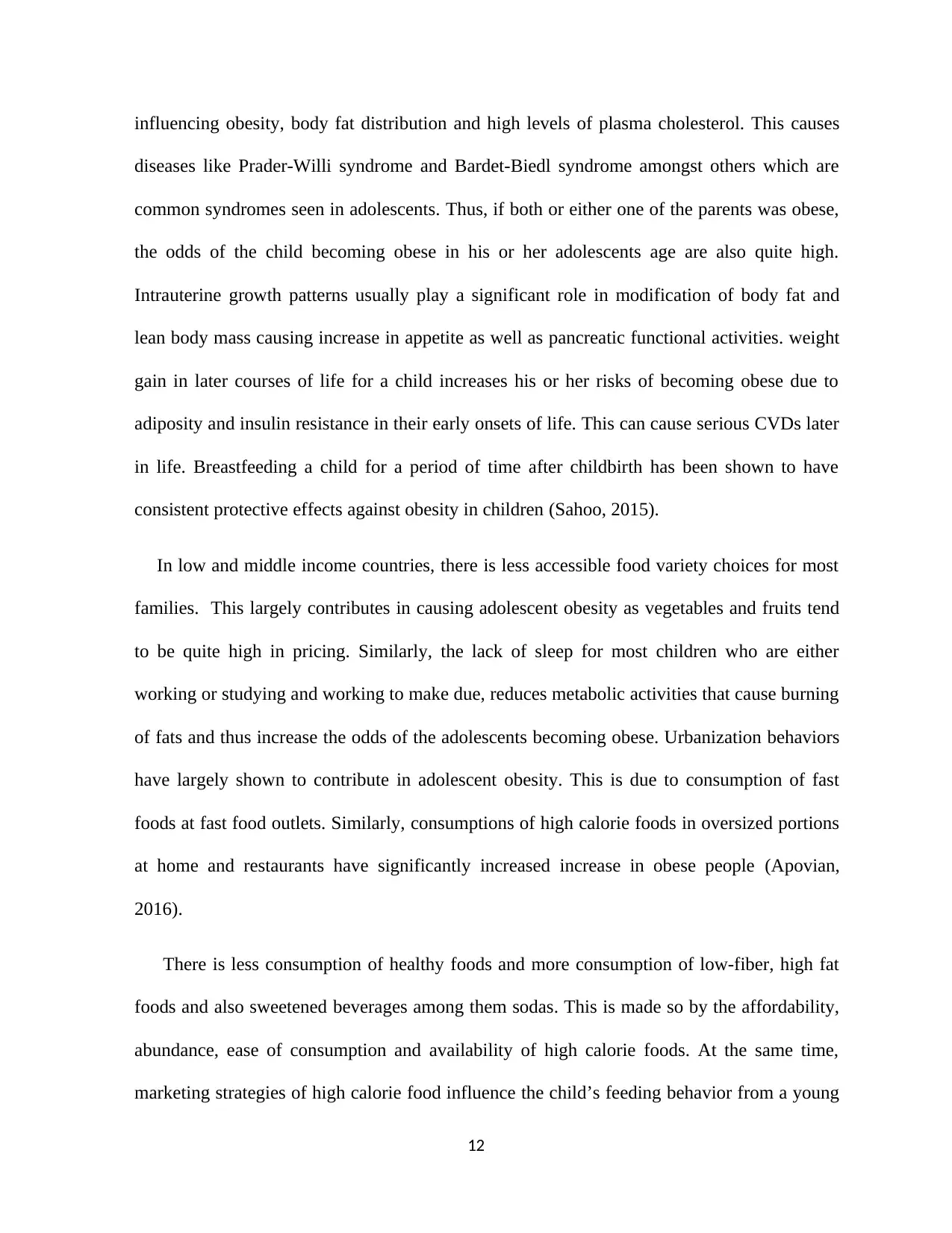
influencing obesity, body fat distribution and high levels of plasma cholesterol. This causes
diseases like Prader-Willi syndrome and Bardet-Biedl syndrome amongst others which are
common syndromes seen in adolescents. Thus, if both or either one of the parents was obese,
the odds of the child becoming obese in his or her adolescents age are also quite high.
Intrauterine growth patterns usually play a significant role in modification of body fat and
lean body mass causing increase in appetite as well as pancreatic functional activities. weight
gain in later courses of life for a child increases his or her risks of becoming obese due to
adiposity and insulin resistance in their early onsets of life. This can cause serious CVDs later
in life. Breastfeeding a child for a period of time after childbirth has been shown to have
consistent protective effects against obesity in children (Sahoo, 2015).
In low and middle income countries, there is less accessible food variety choices for most
families. This largely contributes in causing adolescent obesity as vegetables and fruits tend
to be quite high in pricing. Similarly, the lack of sleep for most children who are either
working or studying and working to make due, reduces metabolic activities that cause burning
of fats and thus increase the odds of the adolescents becoming obese. Urbanization behaviors
have largely shown to contribute in adolescent obesity. This is due to consumption of fast
foods at fast food outlets. Similarly, consumptions of high calorie foods in oversized portions
at home and restaurants have significantly increased increase in obese people (Apovian,
2016).
There is less consumption of healthy foods and more consumption of low-fiber, high fat
foods and also sweetened beverages among them sodas. This is made so by the affordability,
abundance, ease of consumption and availability of high calorie foods. At the same time,
marketing strategies of high calorie food influence the child’s feeding behavior from a young
12
diseases like Prader-Willi syndrome and Bardet-Biedl syndrome amongst others which are
common syndromes seen in adolescents. Thus, if both or either one of the parents was obese,
the odds of the child becoming obese in his or her adolescents age are also quite high.
Intrauterine growth patterns usually play a significant role in modification of body fat and
lean body mass causing increase in appetite as well as pancreatic functional activities. weight
gain in later courses of life for a child increases his or her risks of becoming obese due to
adiposity and insulin resistance in their early onsets of life. This can cause serious CVDs later
in life. Breastfeeding a child for a period of time after childbirth has been shown to have
consistent protective effects against obesity in children (Sahoo, 2015).
In low and middle income countries, there is less accessible food variety choices for most
families. This largely contributes in causing adolescent obesity as vegetables and fruits tend
to be quite high in pricing. Similarly, the lack of sleep for most children who are either
working or studying and working to make due, reduces metabolic activities that cause burning
of fats and thus increase the odds of the adolescents becoming obese. Urbanization behaviors
have largely shown to contribute in adolescent obesity. This is due to consumption of fast
foods at fast food outlets. Similarly, consumptions of high calorie foods in oversized portions
at home and restaurants have significantly increased increase in obese people (Apovian,
2016).
There is less consumption of healthy foods and more consumption of low-fiber, high fat
foods and also sweetened beverages among them sodas. This is made so by the affordability,
abundance, ease of consumption and availability of high calorie foods. At the same time,
marketing strategies of high calorie food influence the child’s feeding behavior from a young
12
⊘ This is a preview!⊘
Do you want full access?
Subscribe today to unlock all pages.

Trusted by 1+ million students worldwide
1 out of 23
Related Documents
Your All-in-One AI-Powered Toolkit for Academic Success.
+13062052269
info@desklib.com
Available 24*7 on WhatsApp / Email
![[object Object]](/_next/static/media/star-bottom.7253800d.svg)
Unlock your academic potential
Copyright © 2020–2025 A2Z Services. All Rights Reserved. Developed and managed by ZUCOL.





